sensor MERCEDES-BENZ SL ROADSTER 2008 Owners Manual
[x] Cancel search | Manufacturer: MERCEDES-BENZ, Model Year: 2008, Model line: SL ROADSTER, Model: MERCEDES-BENZ SL ROADSTER 2008Pages: 317, PDF Size: 5.35 MB
Page 8 of 317
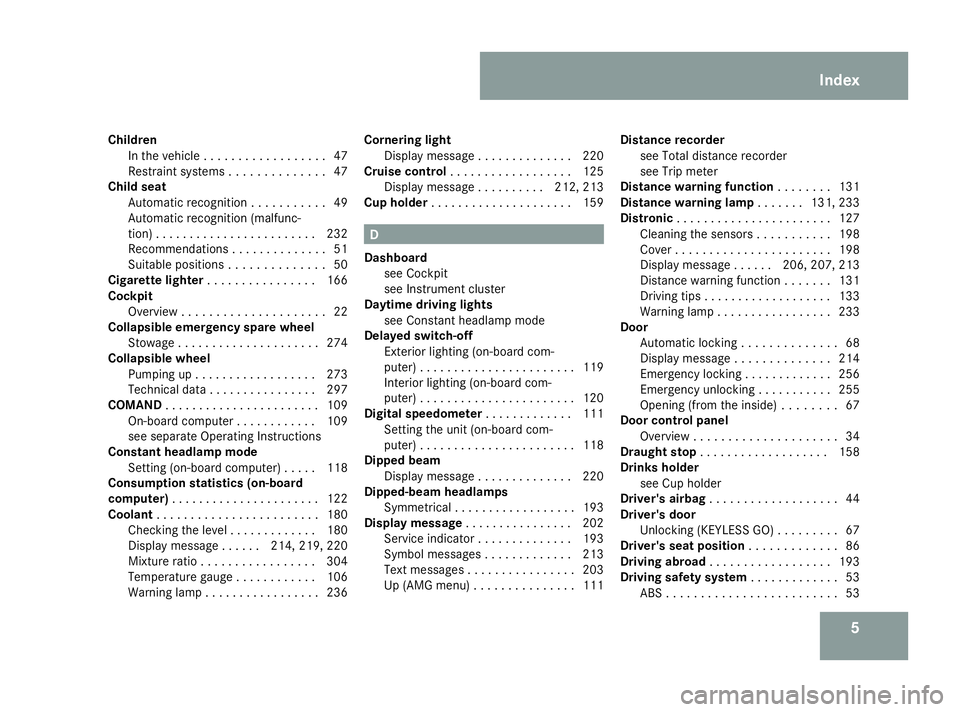
5
Children
In th evehicle .................. 47
Restrai ntsystems .............. 47
Chil dseat
Automatic recognition ...........49
Automatic recognition (malfunc-
tion) ........................ 232
Recommendations ..............51
Suitable positions .............. 50
Ciga rettel ighter ................ 166
Cockpit Overview ..................... 22
Collapsible emergency spare wheel
Stowage ..................... 274
Collapsibl ewheel
Pumping up .................. 273
Technical data ................ 297
COMAND ....................... 109
On-board computer ............109
see separate Operating Instructions
Constant headlamp mode
Setting (on-board computer) .....118
Consumptio nstatistic s(on -board
computer) ...................... 122
Coolant ........................ 180
Checking the leve l.............180
Display message ......214, 219, 220
Mixture ratio ................. 304
Temperature gauge ............106
Warning lamp ................. 236Cornerin
glight
Display message .............. 220
Cruis econtrol .................. 125
Display message ..........212, 213
Cup holder ..................... 159 D
Dashboard see Cockpit
see Instrument cluster
Daytime drivin glights
see Constant headlamp mode
Delaye dswitch-off
Exterior lighting (on-board com-
puter) ....................... 119
Interior lighting (on-board com-
puter) ....................... 120
Digital speedometer .............111
Setting the unit (on-board com-
puter) ....................... 118
Dipped beam
Display message .............. 220
Dipped-beam headlamps
Symmetrical .................. 193
Display message ................ 202
Service indicator .............. 193
Symbo lmessages ............. 213
Text messages ................ 203
Up (AMG menu) ............... 111Distanc
erecorder
see Total distance recorder
see Trip meter
Distanc ewarning function ........131
Distanc ewarning lamp .......131, 233
Distronic ....................... 127
Cleaning the sensors ...........198
Cove r....................... 198
Display message ......206, 207, 213
Distance warning function .......131
Driving tips ................... 133
Warning lamp ................. 233
Door
Automatic locking .............. 68
Display message .............. 214
Emergency locking .............256
Emergency unlocking ...........255
Opening (from the inside) ........67
Door control panel
Overview ..................... 34
Draught stop ................... 158
Drinks holder see Cuph older
Driver's airbag ................... 44
Driver's door Unlocking (K EYLESS GO) ......... 67
Driver's seat position .............86
Drivin gabroad .................. 193
Driving safety system .............53
ABS ......................... 53 Index
230_AKB; 5; 4, en-GB
bjanott,
Version: 2.9.6 2008-04-08T15:09:54+02:00-Seite 5 Dateiname: 6515_3089_02_buchblock.pdf; preflight
Page 11 of 317

8Sea
tbelt.....................2 38
SRS ..................... 41, 235
Tyr ep ressure monitor ..........238
Indicator and warning lamps ......233
Indicator lamp see Indicator and warning lamp
Instrument cluster ..............105
Overview ..................... 26
Selecting the languag e(on-board
computer) ................... 118
Instrument lighting ..............105
Intelligen tLight System ........... 90
Display message .............. 222
Menu (on-board computer) ......120
Interior lighting .................. 91
Automatic control system........ 92
Delayed switch-off (on-board
computer) ................... 120
Manual control ................. 92
Reading lamp .................. 92
Interior mo tion sensor ............ 61
Priming/deactivating (on-board
computer) ...................1 21
Interior stowage compartments
Emergency release .............257
Intermittent wipe
Windscreen wipers ..............93 J
Jack ........................... 200
Operation .................... 270
Jump-starting ................... 279
Jump leads ................... 279 K
Key ............................ 64
Changing the battery ...........259
Checking the battery ...........259
Closing the roof ............... 155
Display message ....................... 226, 227
Factory setting .............. 64, 65
Loss ........................ 251
Malfunction .................. 251
Modifying the programming .......64
Openin gthe roof .............. 155
KEYLESS GO ..................... 65
Button ....................... 73
Changing the battery ...........259
Checking the battery ...........259
Closing the boot lid automatically ..71
Factory settings ................ 66
Losing the key ................ 254
Malfunction .................. 253
Modifying the programming .......66
Starting the engine ..............96Keyp
ositions
Key .......................... 73
KEYLESS GO .................. 73
Kickdown .............. 101, 103, 105 L
Lamp Display message .............. 220
Lamps
see Indicator and warning lamp
Licenc eplate lighting
Display message .............. 222
Lighting
see Lights
Lights
Active light function .............90
Automatic headlamp mode .......88
Constant headlamp mod e........87
Corneri nglight function .......... 90
Dipped-bea mheadlam ps......... 87
Display message .............. 220
Fog lights .................. 88, 91
Hazard warning lamps ...........90
Headlamp flasher ............... 89
Light switch ................... 87
Main-beam headlam ps........... 89
Motorway mode ................ 91
Rear fo glamp .................. 88
Switching off (displaym essage)...223
Turn signals ................... 89Index
230_AKB; 5; 4, en-GB
bjanott,
Version: 2.9.6 2008-04-08T15:09:54+02:00-Seite 8 Dateiname: 6515_3089_02_buchblock.pdf; preflight
Page 13 of 317
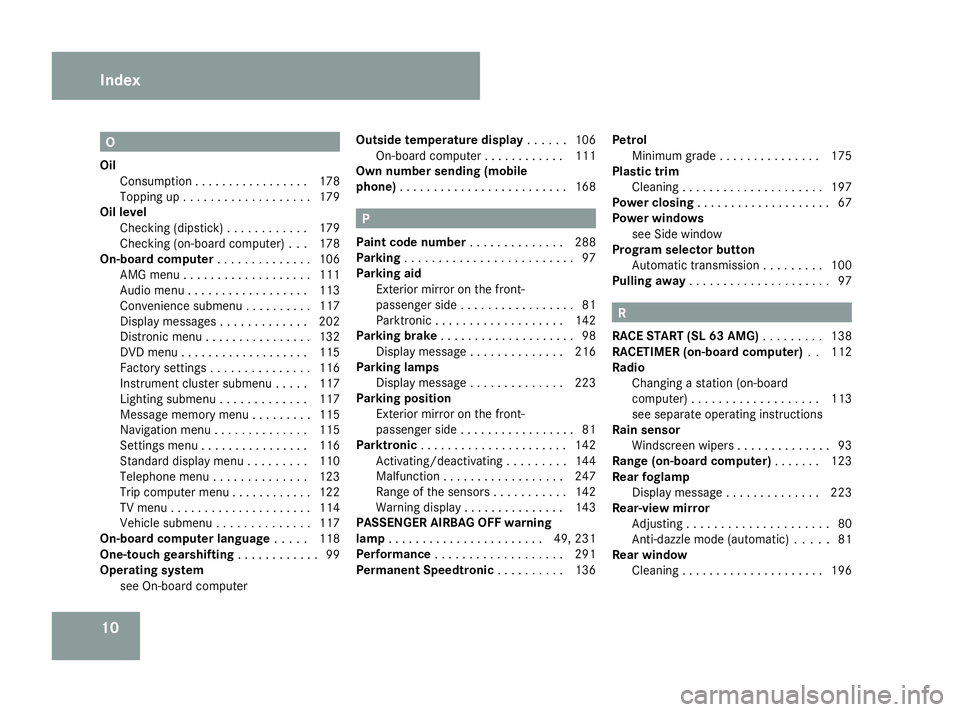
10 O
Oil Consumption ................. 178
Topping up ................... 179
Oil level
Checking (dipstick) ............179
Checking (on-board computer) ...178
On-board computer ..............106
AMG menu ................... 111
Audi omenu .................. 113
Convenience submenu ..........117
Display messages .............202
Distronic menu ................ 132
DVD menu ................... 115
Factory settings ............... 116
Instrument cluster submenu .....117
Lighting submenu .............117
Message memory menu .........115
Navigation menu .............. 115
Settings menu ................ 116
Standard displa ymenu ......... 110
Telephone menu .............. 123
Trip computer menu ............122
TV menu ..................... 114
Vehicle submenu .............. 117
On-board computer language .....118
One-touch gearshifting ............99
Operating system see On-boar dcomputer Outsid
etemperature display ......106
On-board computer ............111
Own number sending (mobile
phone) ......................... 168 P
Pain tcoden umber .............. 288
Parking ......................... 97
Parking aid Exterior mirro ronthe front-
passenger side ................. 81
Parktronic ................... 142
Parking brake .................... 98
Display message .............. 216
Parking lamps
Display message .............. 223
Parking position
Exterior mirror on the front-
passenger sid e................ .81
Parktronic ...................... 142
Activating/deactivating .........144
Malfunction .................. 247
Range of the sensors ...........142
Warning displa y............... 143
PASSENGE RAIRBAG OFF warning
lamp ....................... 49, 231
Performance ................... 291
Permanent Speedtronic ..........136Petrol
Minimum grad e.............. .175
Plastic trim
Cleaning ..................... 197
Power closing .................... 67
Powerw indows
see Side window
Program selector button
Automatic transmission .........100
Pulling away ..................... 97 R
RAC ESTART (S L63AMG)......... 138
RACETIME R(on-board computer) ..112
Radio Changing astatio n(on-board
computer) ................... 113
see separate operating instructions
Rain sensor
Windscreen wipers ..............93
Range (on-board computer) .......123
Rear foglamp Display message .............. 223
Rear-vie wmirror
Adjusting ..................... 80
Anti-da zzlem ode( automatic) .....81
Rear window
Cleaning ..................... 196Index
230_AKB; 5; 4, en-GB
bjanott,
Version: 2.9.6 2008-04-08T15:09:54+02:00-Seite 10 Dateiname: 6515_3089_02_buchblock.pdf; preflight
Page 34 of 317
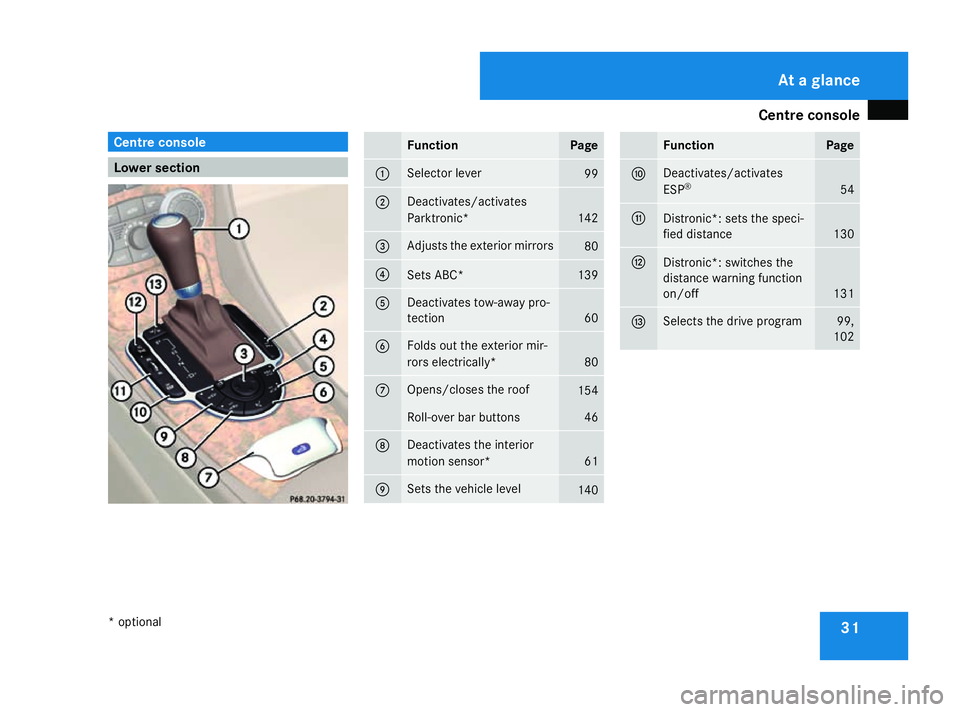
Centre console
31Centre console
Lower section Function Page
1 Selector lever
99
2 Deactivates/activates
Parktronic*
142
3 Adjusts the exterior mirrors
80
4
Set
sABC* 139
5 Deactivates tow-away pro-
tection
60
6 Folds out the exterior mir-
ror
se lectrically* 80
7 Opens/closes the roof
154
Roll-over bar buttons 46
8 Deactivates the interior
motion sensor*
61
9 Set
sthe vehicle level 140 Function Page
a Deactivates/activates
ESP
® 54
b
Distronic*: set
sthe speci-
fied distance 130
c
Distronic*: switches the
distanc
ewarnin gfunction
on/off 131
d Selects the driv
eprogram 99,
102 At
ag lance
*o ptional
230_AKB; 5; 4, en-GB
bjanott ,V ersion: 2.9.6
2008-04-08T15:09:54+02:00
-Seite 31 Dateiname: 6515_3089_02_buchblock.pdf; preflight
Page 36 of 317
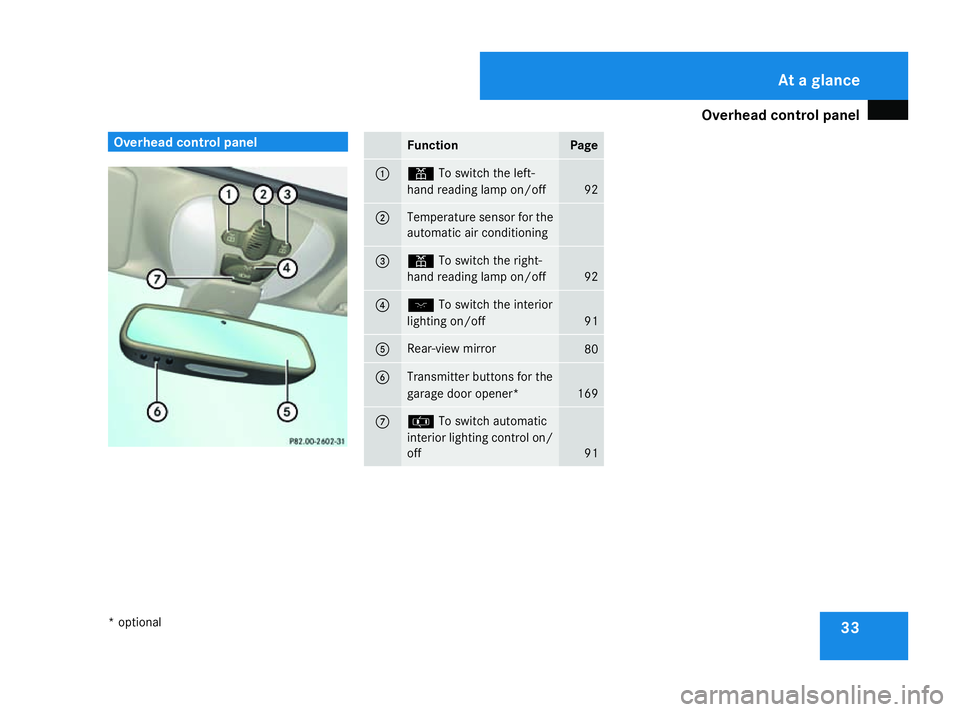
Overhea
dcontrol panel 33Overhea
dcontrol panel Function Page
1 X
To switch the left-
hand reading lamp on/off 92
2 Temperature sensor for the
automatic air conditioning
3 X
To switch the right-
hand reading lamp on/off 92
4 ð
To switch the interior
lightin gon/off 91
5 Rear-view mirror
80
6 Transmitter buttons for the
garage door opener*
169
7 ¤
To switch automatic
interior lightin gcontrol on/
off 91 At
ag lance
*o ptional
230_AKB
;5;4,en-GB
bjanott, Version:2.9.6
2008-04-08T15:09:54+02:0
0-Seite 33 Dateiname: 6515_3089_02_buchblock.pdf; preflight
Page 44 of 317
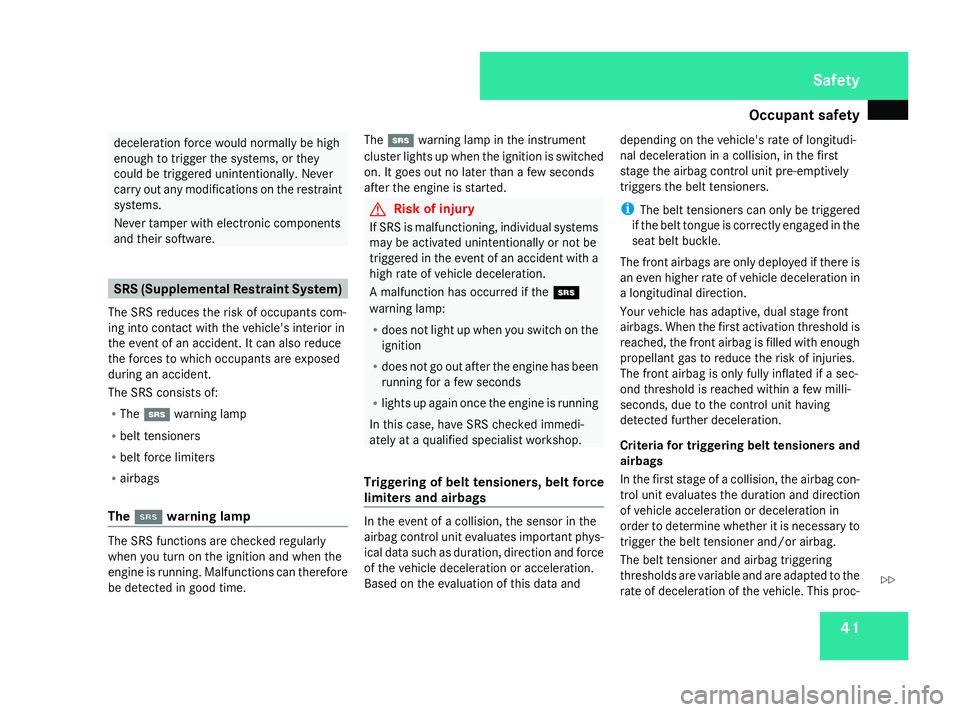
Occupant safety
41deceleration forc
ewould normally be high
enough to trigger the systems ,orthey
could be triggered unintentionally. Never
carry out any modifications on the restraint
systems.
Never tamper with electronic components
and their software. SRS (Supplementa
lRestraint System)
The SRS reduces the risk of occupants com-
ing int ocontact with the vehicle's interior in
the event of an accident. It can also reduce
the forces to which occupants are exposed
during an accident.
The SRS consists of:
R The 1 warning lamp
R belt tensioners
R belt forc elimiters
R airbags
The 1 1 warning lamp The SRS function
sare checked regularly
when you turn on the ignition and when the
engin eisrunning. Malfunctions can therefore
be detected in good time. The
1 warning lamp in the instrument
cluster lights up when the ignition is switched
on. It goes out no later than afew seconds
after the engin eisstarted. G
Risk of injury
If SRS is malfunctioning, individual systems
may be activated unintentionally or not be
triggered in the event of an acciden twith a
high rate of vehicle deceleration.
Am alfunction has occurred if the 1
warning lamp:
R does not light up when you switch on the
ignition
R does not go out after the engin ehas been
running for afew seconds
R lights up again onc ethe engin eisrunning
In this case, have SRS checked immedi-
ately at aqualified specialist workshop.
Triggering of belt tensioners, belt force
limiter sand airbags In the event of
acollision, the sensor in the
airbag control unit evaluates important phys-
ical data such as duration, direction and force
of the vehicle deceleration or acceleration.
Based on the evaluation of this data and depending on the vehicle's rate of longitudi-
nal deceleration in
acollision, in the first
stage the airbag control unit pre-emptively
trigger sthe belt tensioners.
i The belt tensioners can only be triggered
if the belt tongue is correctly engaged in the
seat belt buckle.
The fron tairbags are only deployed if ther eis
an even higher rate of vehicle deceleration in
al ongitudinal direction.
Your vehicle has adaptive, dual stage front
airbags. When the first activation threshold is
reached, the fron tairbag is filled with enough
propellant gas to reduce the risk of injuries.
The fron tairbag is only fully inflated if asec-
ond threshold is reached within afew milli-
seconds, due to the control unit having
detected further deceleration.
Criteria for triggering belt tensioners and
airbags
In the first stage of acollision, the airbag con-
trol unit evaluates the duration and direction
of vehicle acceleration or deceleration in
order to determine whether it is necessary to
trigger the belt tensioner and/or airbag.
The belt tensioner and airbag triggering
thresholds are variable and are adapted to the
rate of deceleration of the vehicle. This proc- Safety
230_AKB
;5;4,en-GB
bjanott, Version:2.9.6
2008-04-08T15:09:54+02:0
0-Seite 41 ZDateiname: 6515_3089_02_buchblock.pdf; preflight
Page 45 of 317

Occupant safety
42
ess is pre-emptive in nature as the airbag
must be deployed during –and not at the end
of –t he collision.
i Airbags are not deployed in all types of
accidents. They are controlled by complex
sensor technology and evaluation logic.
This proces sispre-emptive in nature as
airbag deployment must take place during
the impact and must be adapted to provide
calculated, additional protection for the
vehicle occupants. Not all airbags are
deployed in an accident.
The differen tairbag systems work inde-
pendently of each other .However, each
individual system depends on the type of
acciden tdetermined by the control system
in the first stages of the collision (head-on
collision, side impact ,rear-en dcollision
and overturn) and the extent of the acci-
dent (in particular, the vehicle's rate of
deceleration or acceleration).
The rate of vehicle deceleration or accelera-
tion and the direction of the forc eare basi-
cally determined by:
R the distribution of forces during the colli-
sion
R the collision angle R
the deformation characteristic softhe vehi-
cle
R the characteristic softhe objec twith which
the vehicle has collided, e.g. the other vehi-
cle
Factors which can only be seen and measured
after the collision has taken place do not play
ad ecisive role in the deployment of an airbag,
nor do they provide an indication of it.
The vehicle may be deformed significantly,
e. g. on the bonnet or the wing, without an
airbag being deployed. This happens if only
parts which are relatively easily deformed are
affected and the necessary deceleration does
not occur. Conversely, airbags may be
deployed even though the vehicle suffers only
minor deformations .This is the case if, for
example, very rigid vehicle parts such as lon-
gitudinal body members are affected and suf-
ficien tdeceleration occurs as aresult.
Belt tensioners, belt force limiters The seat belts are fitted with belt tensioners.
!
Do not engage the seat belt tongue in the
buckle on the front-passenger seat if the
seat is not occupied. Otherwise the belt
tensioner could be activated in an emer-
gency. If the seat belt is also equipped with
abelt
forc elimiter, the forc eexerted by the seat
belt on the seat occupant is reduced.
Belt tensioners tighten the seat belts in an
accident, pulling them close against the body.
i Belt tensioners do not correct incorrect
seat position sorincorrectly fastened seat
belts.
Belt tensioners do not pull occupants back
towards the backrest.
The belt forc elimiters are synchronised with
the fron tairbags, which spread the forces
exerted by the belt forc elimiters on the occu-
pant over agreater area.
The seat belts have an automatic comfort-fit
feature. This reduces the retraction forc eof
the seat belts, which results in increased seat
belt comfort.
When the ignition is switched on, the belt ten-
sioner is triggered:
R only if the restraint systems are operational
(the 1 warning lamp lights up after the
ignition is switched on and goes out once
the engin eisrunning)(Y page 41)
R for each three-poin tseat belt in the fron tof
the vehicle when the belt tongue is
engaged in the buckle Safety
230_AKB
;5;4,en-GB
bjanott, Version:2.9.6
2008-04-08T15:09:54+02:0
0-Seite 42 Dateiname: 6515_3089_02_buchblock.pdf; preflight
Page 52 of 317
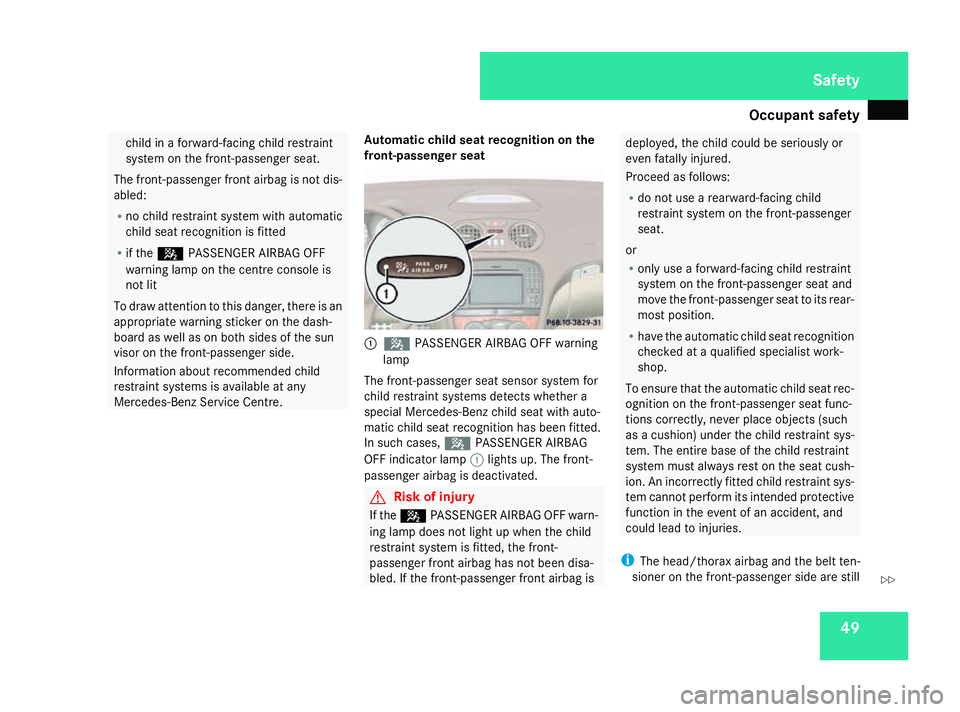
Occupant safety
49child in
aforward-facin gchild restraint
system on the front-passenger seat.
The front-passenger fron tairbag is not dis-
abled:
R no child restraint system with automatic
child seat recognition is fitted
R if the 5 PASSENGER AIRBA GOFF
warning lamp on the centre console is
not lit
To draw attention to this danger, ther eisan
appropriate warning sticker on the dash-
board as well as on both sides of the sun
visor on the front-passenger side.
Information about recommended child
restraint systems is available at any
Mercedes-Benz Service Centre. Automatic child seat recognition on the
front-passenger seat 1
5 PASSENGER AIRBAG OFF warning
lamp
The front-passenger seat sensor system for
child restraint systems detectsw hether a
special Mercedes-Benzc hild seat with auto-
matic child seat recognition has been fitted.
In such cases, 5PASSENGER AIRBAG
OFF indicator lamp 1lights up. The front-
passenger airbag is deactivated. G
Risk of injury
If the 5 PASSENGER AIRBAG OFF warn-
ing lamp does not light up when the child
restraint system is fitted, the front-
passenger front airbag has not been disa-
bled. If the front-passenger front airbag is deployed, the child could be seriously or
even fatally injured.
Proceed as follows:
R
do not use arearward-facing child
restraint system on the front-passenger
seat.
or
R only use aforward-facing child restraint
system on the front-passenger seat and
move the front-passenger seat to its rear-
most position.
R have the automatic child seat recognition
checked at aqualified specialist work-
shop.
To ensure that the automatic child seat rec-
ognition on the front-passenger seat func-
tions correctly, never place objects( such
as ac ushion) under the child restraint sys-
tem. The entire base of the child restraint
system must always rest on the seat cush-
ion. An incorrectly fitted child restraint sys-
tem cannot perform its intended protective
function in the event of an accident, and
could lead to injuries.
i The head/thorax airbag and the belt ten-
sioner on the front-passenger side are still Safety
230_AKB; 5; 4, en-GB
bjanott ,V ersion: 2.9.6
2008-04-08T15:09:54+02:00
-Seite 49 ZDateiname: 6515_3089_02_buchblock.pdf; preflight
Page 53 of 317
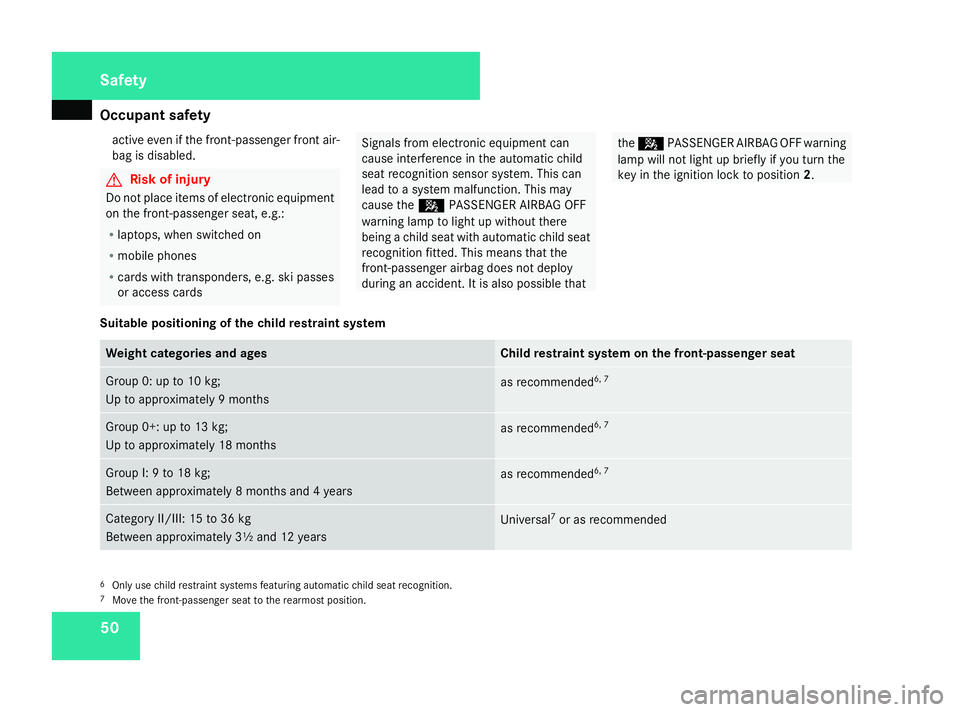
Occupant safety
50activ
eeven if the front-passenger fron tair-
bag is disabled. G
Risk of injury
Do not place items of electronic equipment
on the front-passenger seat, e.g.:
R laptops, when switched on
R mobile phones
R cards with transponders, e.g. ski passes
or access cards Signals from electronic equipment can
cause interference in the automatic child
seat recognition sensor system. This can
lead to
asystem malfunction .This may
cause the 5PASSENGER AIRBAG OFF
warning lamp to light up without there
being achild seat with automatic child seat
recognition fitted. This means that the
front-passenger airbag does not deploy
during an accident. It is also possible that the
5 PASSENGER AIRBAG OFF warning
lamp will not light up briefly if you turn the
key in the ignition lock to position 2.
Suitable positioning of the child restraint system Weight categories and ages Child restraint system on the front-passenger seat
Group 0: up to 10 kg;
Up to approximately
9months as recommended
6, 7 Group 0+: up to 13 kg;
Up to approximately 18 months
as recommended
6, 7 Group I:
9to18k g;
Between approximately 8months and 4years as recommended
6, 7 Category II/III: 15 to 36 kg
Between approximately 3½ and 12 years
Universal
7
or as recommended 6
Only use child restraint systems featurin gautomatic child seat recognition.
7 Move the front-passenger seat to the rearmost position. Safety
230_AKB
;5;4,en-GB
bjanott, Version:2.9.6
2008-04-08T15:09:54+02:0
0-Seite 50 Dateiname: 6515_3089_02_buchblock.pdf; preflight
Page 64 of 317

Anti-thef
tsyste ms 61Interio
rmotio nsenso r*
If the interior motio nsensorisp rimed, avis-
ua land audibl ealarm is triggered if move-
ment is detected in the vehicl einterior while
the vehicl eislocked .Thiso ccurs, for exam-
ple, if someone breaks the side windows of
your vehicl eorreaches into the vehicle' sinte-
rior.
Primin gthe interio rmotio nsensor X
Make sure that:
R
the side windows ar eclosed
R the roo fisclosed
R the stowage compartments unde rthe
armrest ar eclosed
R there ar enoobjects, e.g .mascots, hang-
ing on the rear-view mirro roronthe
grasp handles on the roo ftrim.
This will prevent fals ealarm s.
X Make sure tha tthe boot li disclosed.
Onl ythe nc an the interior motio nsensorbe
primed.
X Lock the vehicl eusing the key .Onvehicles
with KEYLESS GO*, the locking button on the door handle/boo
tlid cana lsobeu sed
to lock the vehicle.
Th einterior motio nsensorisp rimed after
approximatel y30seconds.
Th ef actor ysettin gist hatthe interior motion
senso risnot primed if the roo fisopen. You
ca nu sethe on-board computer to change the
settings so tha tthe interior motio nsensoris
primed even when the roo fisopen
( Y page 121).
i Yous hould always clos ethe roo fwhen
yo up arky ourv ehicle to prevent afalse
alar mb eing triggered ,for example by fall-
ing leaves or insects .Incertaincountries,
the interior motio nsensorisp rimed even
when the roo fisopen.
i Do not plac eanyobject sonthe armrest
in the centre console. This could otherwise
interfere with the interior motio nsensor.
Metalli cobject scoming into contac twith
other metalli cobject sm aytrigger afalse
alarm. Therefore ,donot leav eobject ssuch
as ab unch of key sinornext to the armrest.
Us ead ifferent lockabl estowage compart-
ment for such items. To deactivate the interio
rmotio nsen-
sor To prevent
afalse alarm, deactivate the inte-
rior motio nsensorify oulock your vehicl eand
R people remain in the vehicle
R animal sremain in the vehicle
R the windows remain open. 1
Indicato rlamp
2 To deactivate the interior motio nsensor Safety
*o ptional
230_AKB; 5; 4, en-GB
bjanott,
Version: 2.9.6 2008-04-08T15:09:54+02:00-Seite 61 ZDateiname: 6515_3089_02_buchblock.pdf; preflight